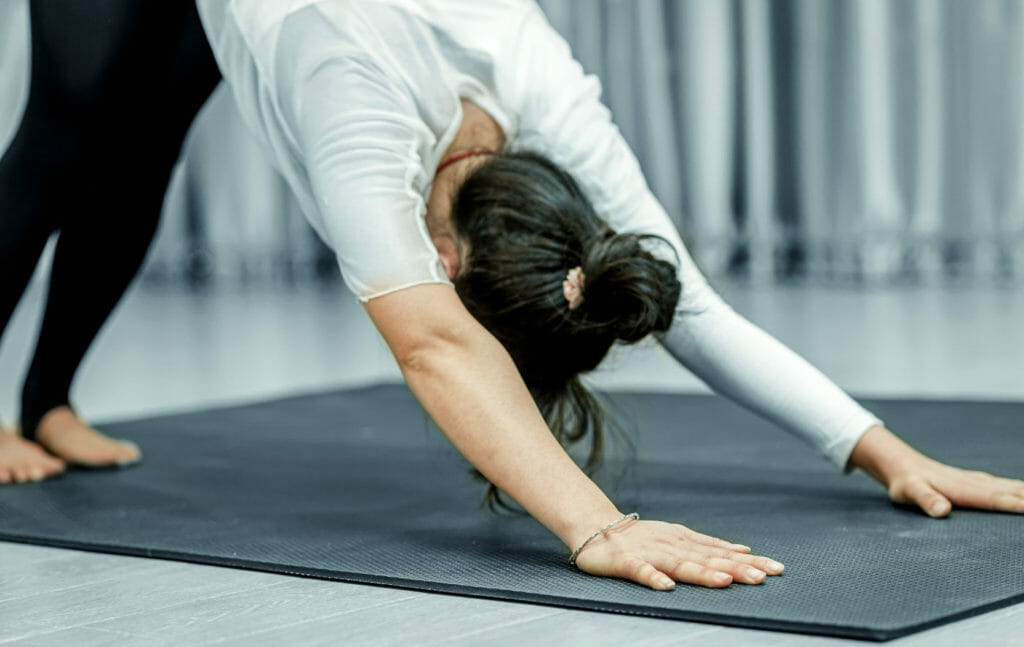
Sciatic nerve pain can be debilitating in many ways. Not only can it interfere with your daily life and ability to work and play, it can significantly disrupt your sleep cycle and keep you from getting the rest you need.
Not getting enough sleep isn’t good for you, so let’s take a look at how to relieve your sciatic nerve pain so you can get back to sleeping well and enjoying your regular activities.
Exercises to Help Relieve Sciatic Nerve Pain
When you’re dealing with pain, exercise might feel counterintuitive. But one recent study found that gentle exercise was just as effective as bed rest in helping relieve sciatic nerve pain.
Regular exercise keeps your back strong, and helps protect your spine and nerves. The next time you need to relieve your sciatic nerve pain, try some of these easy exercises and see if they help.
Downward-Facing Dog

Tight hamstrings can put pressure on the sciatic nerve and lead to pain. Downward-facing dog is a great pose for stretching the hamstring muscles while strengthening the muscles around the sciatic nerve.
Doing downward-facing dog safely requires full-body engagement. Make sure to maintain proper spinal alignment and relax your neck and shoulder muscles. Here’s how to do downward dog to relieve sciatic nerve pain:
- Start from your hands and knees with your back flat.
- Make sure your hands are firmly on the ground about shoulder width apart, your arms are parallel to each other and your neck and shoulders are relaxed.
- Tuck your toes with your feet about hip width apart, and press against the ground with your hands so that your legs start to straighten.
- Adjust your feet farther away from your hands if you need to.
- Try to relax your neck so your head hangs down.
The goal is to feel good. You should be able to feel that your spine is in proper alignment. Hold the pose for as little as 10-15 seconds to start, or up to 1-2 minutes.
Cobra Pose
Sciatic nerve pain can also result from nerve irritation due to abnormal intervertebral discs. In this study, patients with disc problems had increased stiffness of the sciatic nerve compared to a healthy group.
Activities that only use the front side of the body or involve prolonged sitting are a recipe for sciatic nerve pain. That means sitting at a desk isn’t going to help!
A yoga posture called cobra pose is another great way to relieve sciatic nerve pain. It allows you to open up your chest while strengthening your hip flexors, alleviating pressure between the discs in your spine.
- Lie on a yoga mat or carpeted floor on your stomach with your legs straight.
- Place your hands on the floor right underneath your shoulders.
- Slowly straighten your arms, pushing up gently.
- Relax your head and shoulder muscles. If it feels good, you can look up.
Start by holding the pose for a short time like 10-15 seconds, but work up to holding it for 1-2 minutes.
Low Lunge
Low lunge is another stretch that helps activate your hip flexors, relieving pressure on the sciatic nerve and therefore helping to relieve sciatic nerve pain.
- Stand with your feet together. Then take a big step forward with one foot, bending your front knee. The other leg should be extended behind you.
- Carefully lower your back knee to the floor and untuck your back toes.
- Relax your arms or reach them forward, feeling the stretch in your back quad and hip flexor.
Hold the lunge for 30 seconds to 1 minute. Then return to your starting position and switch legs.
Glute Bridge Pose

Glute bridge pose activates your glutes, hips, lower back, and core. Studies have shown that glute bridge pose helps to promote better spine alignment and prevent nerve pain.
- Lie on your back on a yoga mat or carpeted floor with your arms by your sides.
- Bend your knees and keep your feet planted firmly on the ground. Your head and hands should be on the ground, too.
- Gently lift your hips off the ground, pushing with your glutes (the big muscles in your butt) until your body is in a straight line from your chest to your knees.
- Keep the rest of your body nice and relaxed.
- Lower your hips back down to the ground.
If glute bridge pose feels good to you, perform 5-10 repetitions.
Eye of the Needle Pose
This pose is so effective because it directly stretches the permoris muscles, which surround the sciatic nerve. This stretch helps relieve the pressure that can cause sciatic nerve pain.
- Lie down on your back.
- Bend your knees and bring them in toward your chest.
- Cross the right ankle over the left thigh, letting your right knee to drop gently open to the side.
- Reaching both hands around either side of the left thigh, clasp them around your left hamstring.
- Gently pull the left knee toward the chest while continuing to drop the right knee open.
Hold this pose for 30 seconds to 1 minute. Then gently release and repeat on the opposite side.
Promote Proper Posture and Body Mechanics
One of the biggest things you can do to relieve sciatic nerve pain is to ensure all your seats support and comfort your lower back. This is important everywhere you sit: at work, at home on the couch, and in your car. Find a pillow or support for your lower back curve to improve your posture and comfort.
In addition, make sure to maintain proper body mechanics when lifting heavy items. Keep your back straight and your legs spread, and only bend at the knees. Hold the load close to your body and use your leg muscles to lift the item, not your back muscles. Avoid lifting and twisting simultaneously.
The Best Sleeping Positions for Sciatic Nerve Pain

Finding the most comfortable sleeping position can help calm your sciatic nerve pain while helping you get the sleep you need. Once you find the right position for you, stick to it.
Most people with sciatic nerve pain find it easier to sleep on their backs. If you lie on your back, bend your knees and put a pillow under them to get a little additional comfort.
Sleeping on your side is great, too. You can maximize comfort while sleeping on your side by bending one knee slightly and pulling it towards your head.
Avoid sleeping on your stomach, as it can cause sciatic nerve irritation.
Medical Treatments for Sciatic Nerve Pain
A recent study strongly suggest exploring non-pharmacological strategies first before looking into pharmacological options. Treating sciatic nerve pain involves addressing the underlying cause. If you can’t relieve your sciatic nerve pain with stretches and changing your sleeping position, the doctor may suggest medication such as anti-inflammatory drugs (ibuprofen, naproxen), muscle relaxants, narcotics, or steroids.
Surgery can be used as a last resort if other treatments are not effective. For instance, if your sciatic nerve pain is caused by the narrowing of the spine, surgery might be required to relieve pressure from the nerve roots. However, surgery only happens in 10-15% of cases.